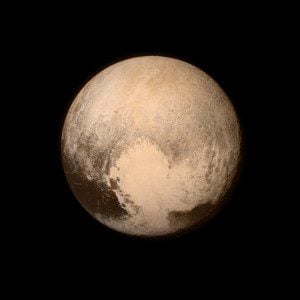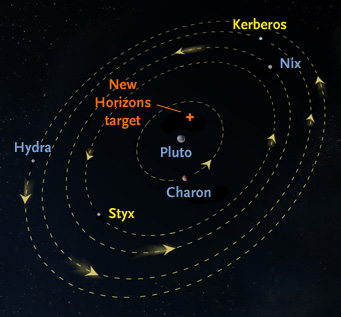
Last night and this morning I sat riveted to my computer. Today we kissed the God of the Underworld and the farthest commonly-known “planet” in our solar system: Pluto. I don’t know if I can effectively communicate my joy and excitement! It was astronomy that I remember as first engaging my sense of wonder and reverence for the beauty of the Universe. It was astronomy and mythology that awoke the Paganism that continues to define my life. To me, as I imagine it is to many, when Pluto was still considered a full planet, this was the last planet in the solar system. This is the guardian of our celestial borders.
And how appropriate, especially now that we know that Pluto and its largest moon, Charon, are really a binary dwarf planet system, with at least four moons that we are aware of; and Charon is the psychopomp who takes us into the Underworld, provided that payment is given.

The two worlds are tidally locked, just as we are to our own Moon, and Charon, being at least 12% of Pluto’s size, does not really orbit Pluto. Instead, they swing around the point where their gravity interacts, a fictional point above Pluto’s surface called the barycenter. Together they are dancing a lovely court dance in the void of space, with Pluto swinging Charon around and circumnavigating a circular “wobble” in the center. They revolve around each other every 6.4 days. Many of the members of the New Horizon’s team are calling it the “Pluto-Charon system.”
At least four moons orbit this dwarf planet binary. We have named them Styx, Nix, Hydra and Kerberos. Styx, Nix and Hydra are in stable orbits around the binary, making their revolutions in a ratio of three, four and six times the length of Charon’s orbit respectively. Astrophysicists believe this is what keeps everything stable to each other; which anyone who has ever played Super Planet Crash knows is really important. We don’t know the length of Kerberos’ orbit, because we only recently found it. And, Kerberos is jet black while the other moons are white, so we have trouble seeing it.

That point is also important; it means that they are made of different materials from each other and the other moons, at least, aren’t exchanging materials with Kerberos. So was it a captured asteroid?
What’s more interesting is that unlike any other moon observed thus far, they don’t keep their faces towards their planet. They speed up and slow down in the revolution of their “days,” and even change direction, swinging their poles towards and away from the planet.
There’s more cool stuff. Pluto is, unexpectedly, less than a third ice. And yes, that’s probably water ice. That’s definitely not what we anticipated of such a cold and distant world. And it’s pink! The current theory as to why is that Pluto is off-gassing its primarily nitrogen and methane atmosphere.
Did you catch that? It has an atmosphere! And it’s likely exchanging that atmosphere with Charon. I haven’t seen anyone point this out yet, but that’s not a far cry from what Earth’s atmosphere was like in our early existence; plants eventually changed it all into what it is today (read about the Burgess Shale).

The path to future exploration has been mapped. Obviously the astronauts of the future will hop from oasis to oasis on our way out of the system, carrying food and food crops with them. Maybe we’ll set up supply depots so that astronauts can grab what they need on the way by. And with NASA seriously working on an ion drive idea, this might not be science fiction much longer.
I wonder what Pluto (and/or Hades) thinks about all of this? I also can’t help but wonder why nobody thought to name one of the moons for Persephone? But at least we’re being consistent about naming features on Pluto and Charon for Underworld deities and places; though I’m not sure I feel comfortable with anything that far in the darkness of the void being named for Cthulu.

More data is coming back all the time, and I hope you’re all watching it as excitedly as I am! The New Horizons craft is still working and has reported back home; there’s about a twelve hour lull between where it is and the data’s release. And now we’re venturing out into the Third Zone of the solar system, otherwise known as the Kuiper Belt, where only Voyager has ever been before. We know there are several more interesting bodies, and maybe some dwarf planets out there to discover.
In the meantime, India has gone to Mars, and China is working on going to the Moon. Have we sparked a new Space Race after all this time? This confirmed sci-fi geek and witch sincerely hopes so. At one time there was a movement to take our industry into space, to mine the almost-literally unlimited energy of the sun to power our industry and off-gas our pollution into a void that does not give a damn what we’re sending into it because it’s full of radiation and toxic gasses anyway. Science fiction writers have been proposing for a long time that our salvation as a species may be among the stars. And maybe they’re right. Today, that doesn’t seem so improbable.
Tomorrow a whole lot of data will be streaming in and we’ll know so much more than we did today. I can’t wait!

I’m creating a Patreon account for those who’d like to consider being my patrons. Thanks for your support!
Like Between the Shadows on Facebook and never miss a post!
















